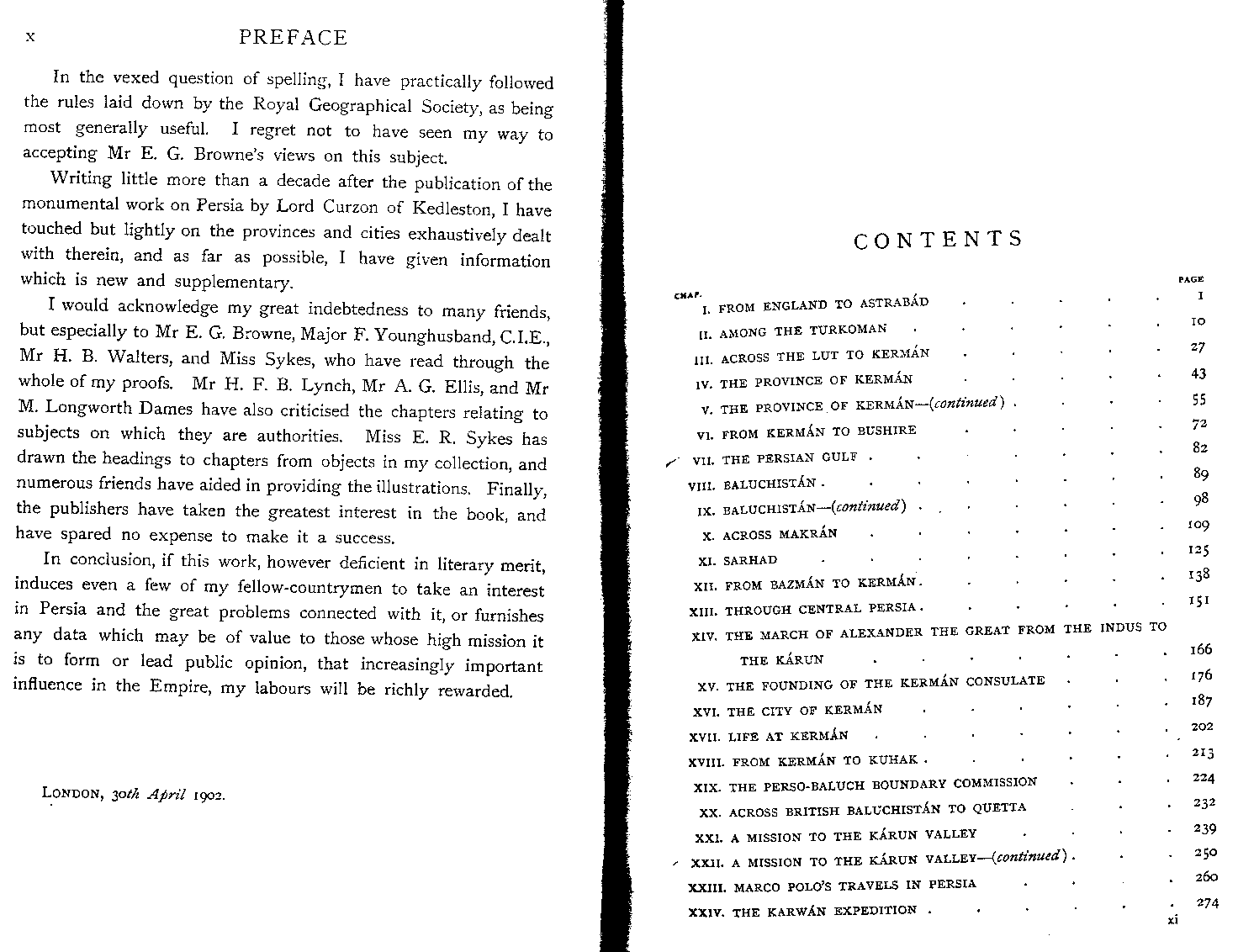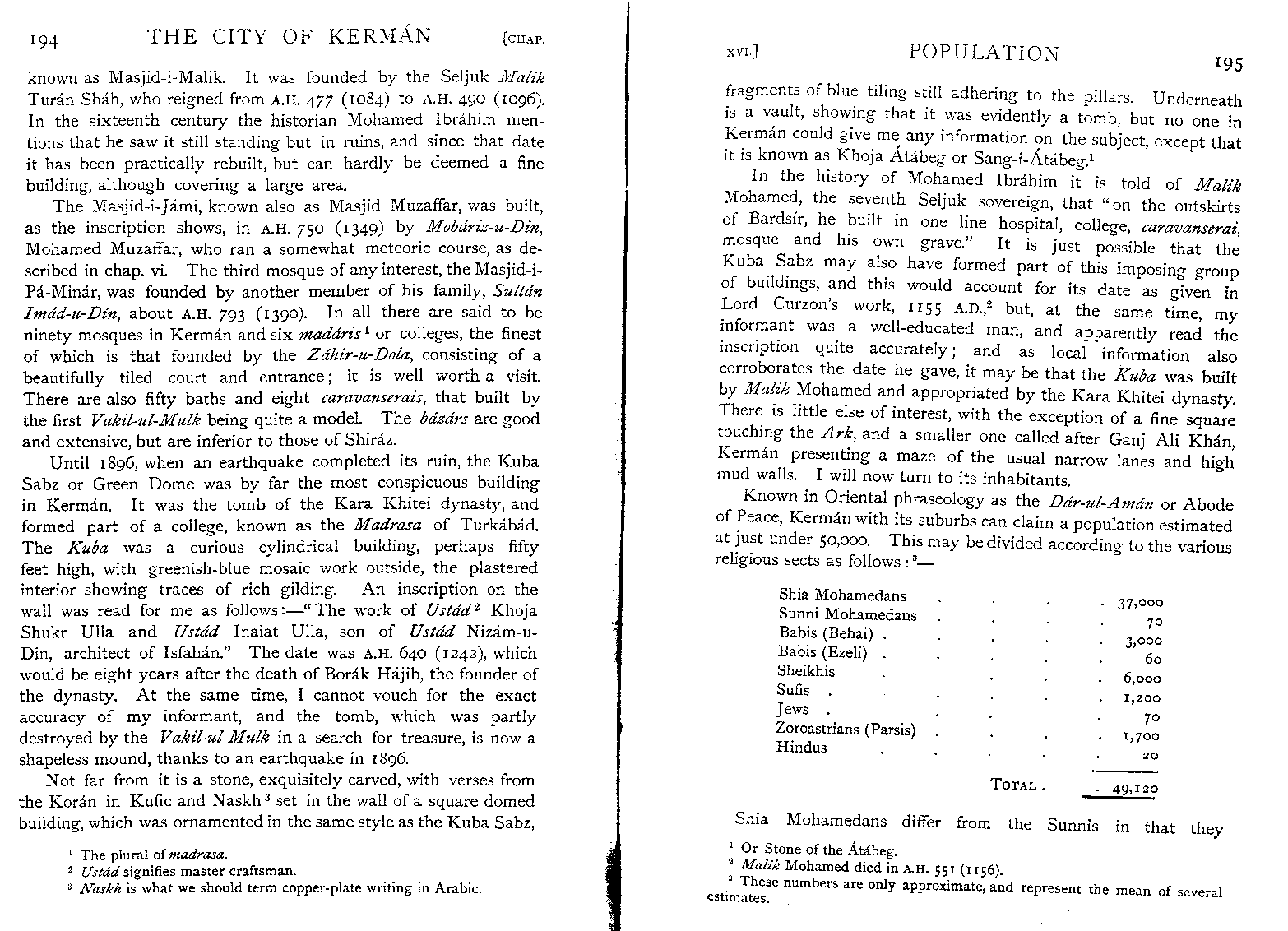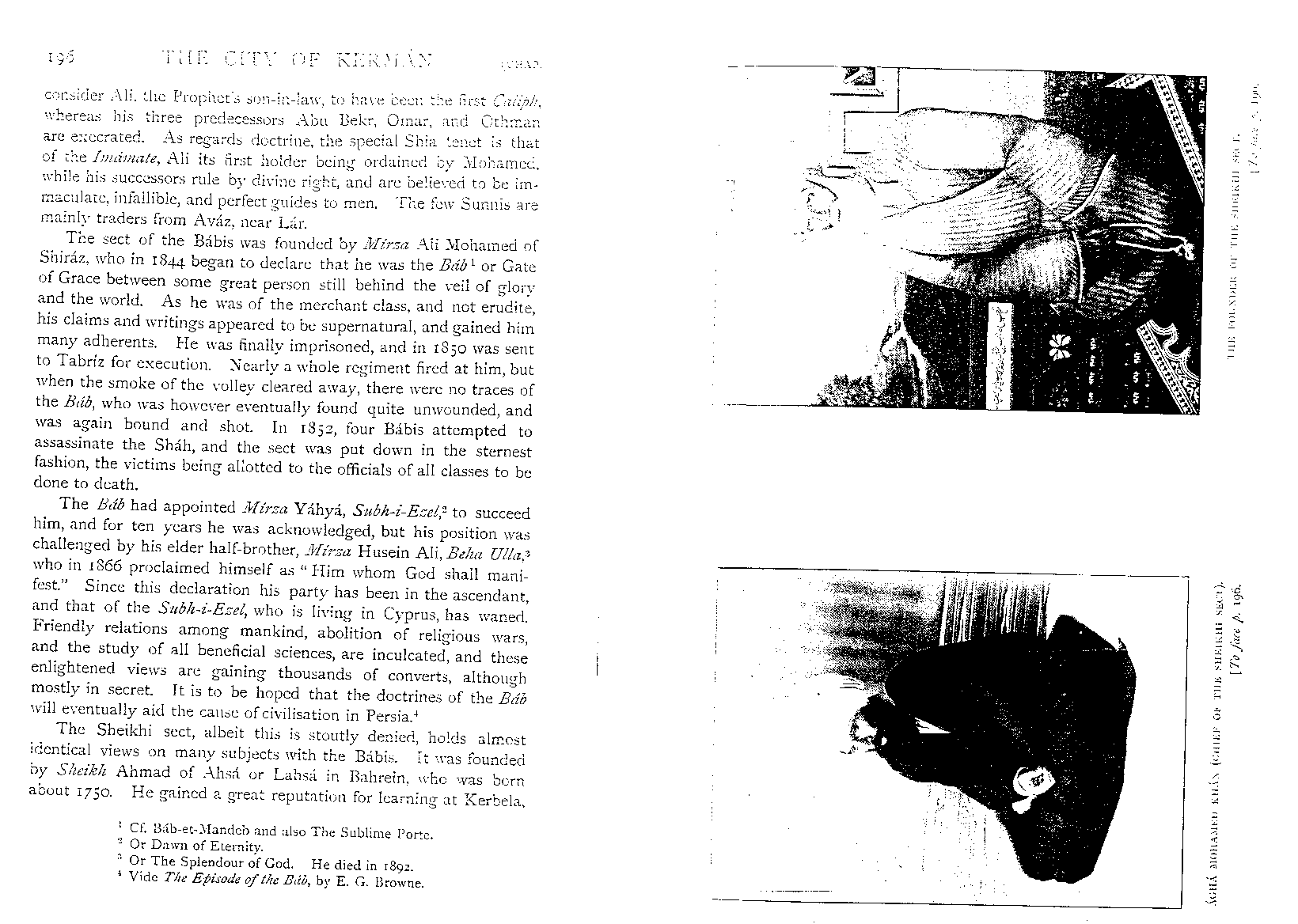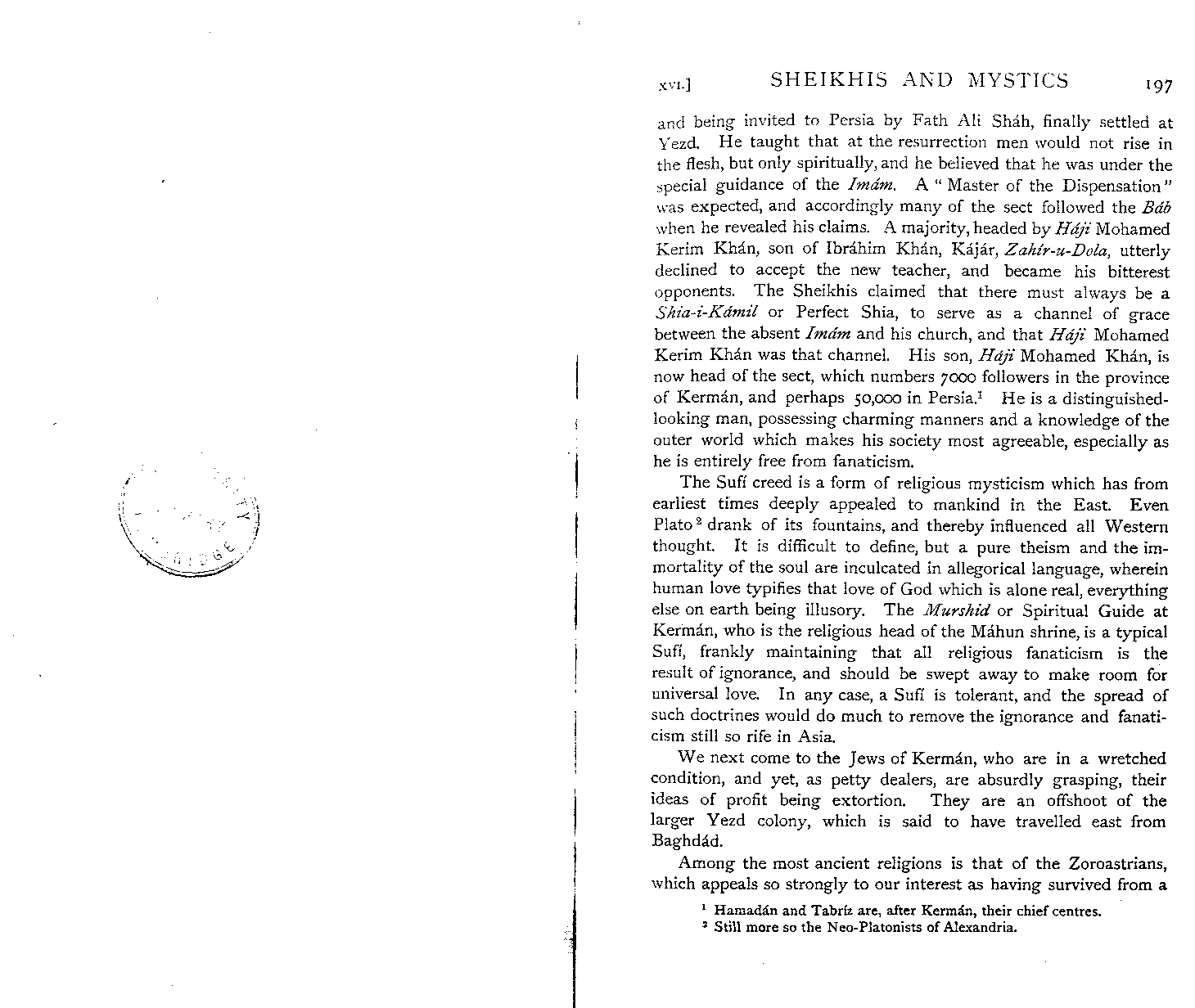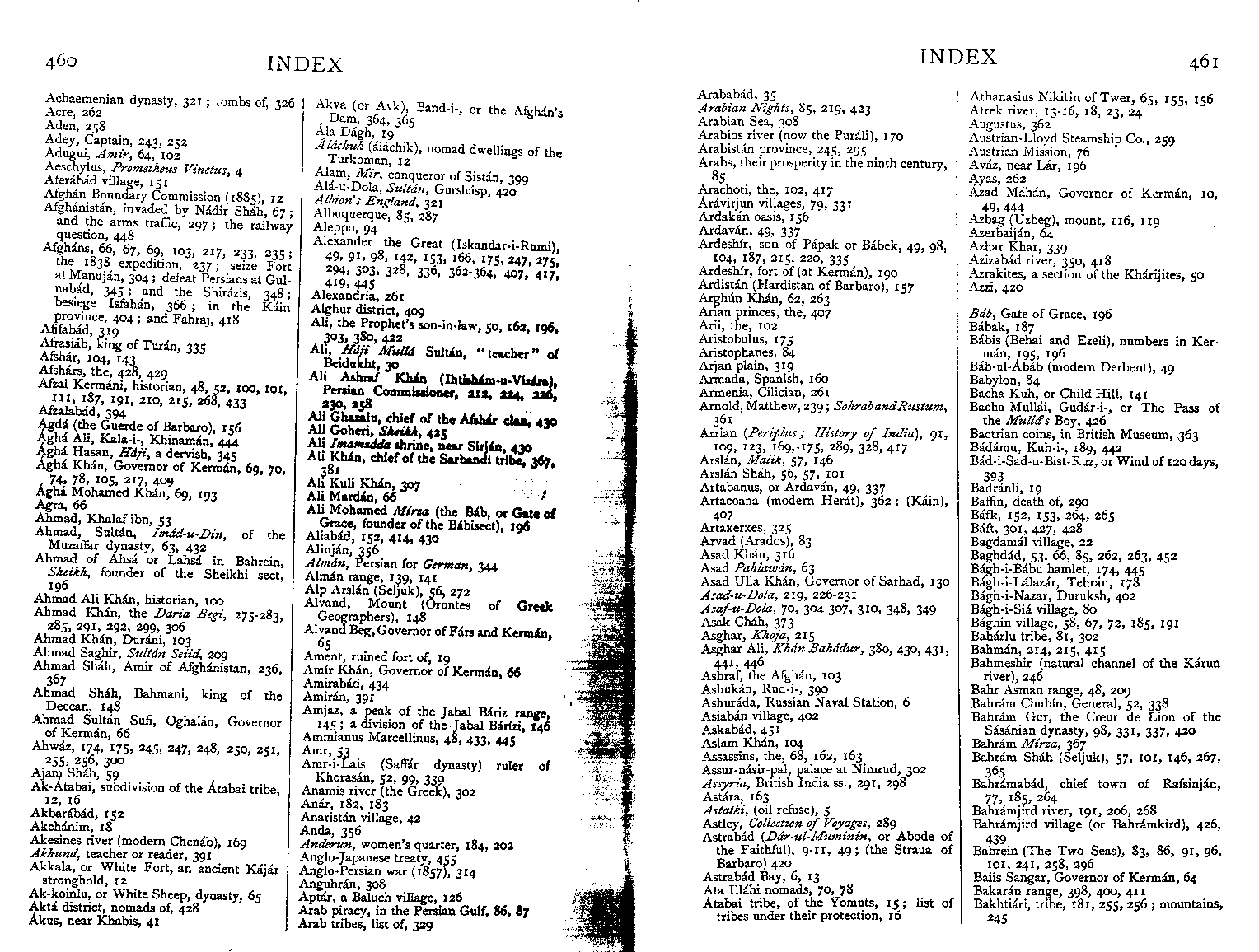
|
|
Abstract: Brief overview of Babism, including estimate of numbers of Bahá'ís and Azalis in Kirman. Notes: Author note: H.M. Consul, Kerman and Persian Bulchistan. Awarded Silver Medal by the Society of Arts, 1897; the Back Grant in 1899; and the Gold Medal in 1902 by the Royal Geographical Society, London. |
Ten Thousand Miles in Persia or Eight Years in Iran
by Percy Molesworth Sykes
pages 194-197London: John Murray, 1902
1. Text
[page 194]... known as Masjid-i-Malik. It was founded by the Seljuk Malik Turán Sháh, who reigned from A.H. 477 (1084) to A.H. 490 (1096). In the sixteenth century the historian Mohamed Ibráhim mentions that he saw it still standing but in ruins, and since that date it has been practically rebuilt, but can hardly be deemed a fine building, although covering a large area.
The Masjid-i-Jámi, known also as Masjid Muzaffar, was built, as the inscription shows, in A.H. 750 (1349) by Mobáriz-u-Din, Mohamed Muzaffar, who ran a somewhat meteoric course, as described in chap. vi. The third mosque of any interest, the Masjid-i-Pá-Minár, was founded by another member of his family. Sultán Imád-u-Dín, about A.H. 793 (1390). In all there are said to be ninety mosques in Kermán and six madáris[1] or colleges, the finest of which is that founded by the Záhir-u-Dola, consisting of a beautifully tiled court and entrance; it is well worth a visit. There are also fifty baths and eight caravanserais, that built by the first Vakil-ul-Mulk being quite a model. The bázárs are good and extensive, but are inferior to those of Shiráz.
Until 1896, when an earthquake completed its ruin, the Kuba Sabz or Green Dome was by far the most conspicuous building in Kermán. It was the tomb of the Kara Khitei dynasty, and formed part of a college, known as the Madrasa of Turkábád. The Kuba was a curious cylindrical building, perhaps fifty feet high, with greenish-blue mosaic work outside, the plastered interior showing traces of rich gilding. An inscription on the wall was read for me as follows: — "The work of Ustád[2] Khoja Shukr Ulla and Ustád Inaiat Ulla, son of Ustád Nizám-u-Din, architect of Isfahán." The date was A.H. 640 (1242), which would be eight years after the death of Borák Hájib, the founder of the dynasty. At the same time, I cannot vouch for the exact accuracy of my informant, and the tomb, which was partly destroyed by the Vakil-ul-Mulk in a search for treasure, is now a shapeless mound, thanks to an earthquake in 1896.
Not far from it is a stone, exquisitely carved, with verses from the Korán in Kufic and Naskh[3] set in the wall of a square domed building, which was ornamented in the same style as the Kuba Sabz,
[page 195]
fragments of blue tiling still adhering to the pillars. Underneath is a vault, showing that it was evidently a tomb, but no one in Kermán could give me any information on the subject, except that it is known as Khoja Átábeg or Sang-i-Átábeg.[4]
In the history of Mohamed Ibráhim it is told of Malik Mohamed, the seventh Seljuk sovereign, that "on the outskirts of Bardsír, he built in one line hospital, college, caravanserai, mosque and his own grave." It is just possible that the Kuba Sabz may also have formed part of this imposing group of buildings, and this would account for its date as given in Lord Curzon's work, 1155 A.D.,[5] but, at the same time, my informant was a well-educated man, and apparently read the inscription quite accurately; and as local information also corroborates the date he gave, it may be that the Kuba was built by Malik Mohamed and appropriated by the Kara Khitei dynasty. There is little else of interest, with the exception of a fine square touching the Ark, and a smaller one called after Ganj Ali Khán, Kermán presenting a maze of the usual narrow lanes and high mud walls. I will now turn to its inhabitants.
Known in Oriental phraseology as the Dár-ul-Amán or Abode of Peace, Kermán with its suburbs can claim a population estimated at just under 50,000. This may be divided according to the various religious sects as follows[6]: —
| Shia Mohamedans | 37,000 |
| Sunni Mohamedan | 70 |
| Babis (Behai) | 3,000 |
| Babis (Ezeli) | 60 |
| Sheikhi | 6,000 |
| Sufi | 1,200 |
| Jews | 70 |
| Zoroastrians (Parsis) | 1,700 |
| Hindus | 20 |
| _______ | |
| TOTAL | 49,120 |
Shia Mohamedans differ from the Sunnis in that they
[page 196]
consider Ali, the Prophet's son-in-law, to have been the first Caliph, whereas his three predecessors Abu Bekr, Omar, and Othman are execrated. As regards doctrine, the special Shia tenet is that of the Imámate, Ali its first holder being ordained by Mohamed, while his successors rule by divine right, and are believed to be immaculate, infallible, and perfect guides to men. The few Sunnis are mainly traders from Aváz, near Lár.
The sect of the Bábis was founded by Mírza Ali Mohamed of Shiráz, who in 1844 began to declare that he was the Báb[7] or Gate of Grace between some great person still behind the veil of glory and the world. As he was of the merchant class, and not erudite, his claims and writings appeared to be supernatural, and gained him many adherents. He was finally imprisoned, and in 1850 was sent to Tabríz for execution. Nearly a whole regiment fired at him, but when the smoke of the volley cleared away, there were no traces of the Báb, who was however eventually found quite unwounded, and was again bound and shot. In 1852, four Bábis attempted to assassinate the Shah, and the sect was put down in the sternest fashion, the victims being allotted to the officials of all classes to be done to death.
The Báb had appointed Mírza Yáhyá, Subh-i-Ezel,[8] to succeed him, and for ten years he was acknowledged, but his position was challenged by his elder half-brother, Mírza Husein Ali, Beha Ulla,[9] who in 1866 proclaimed himself as "Him whom God shall manifest." Since this declaration his party has been in the ascendant, and that of the Subh-i-Ezel, who is living in Cyprus, has waned. Friendly relations among mankind, abolition of religious wars, and the study of all beneficial sciences, are inculcated, and these enlightened views are gaining thousands of converts, although mostly in secret. It is to be hoped that the doctrines of the Báb will eventually aid the cause of civilisation in Persia.[10]
The Sheikhi sect, albeit this is stoutly denied, holds almost identical views on many subjects with the Bábis. It was founded by Sheikh Ahmad of Ahsá or Lahsá in Bahrein, who was born about 1750. He gained a great reputation for learning at Kerbela,
[page 197]
and being invited to Persia by Fath Ali Sháh, finally settled at Yezd. He taught that at the resurrection men would not rise in the flesh, but only spiritually, and he believed that he was under the special guidance of the Imám, A "Master of the Dispensation" was expected, and accordingly many of the sect followed the Báb when he revealed his claims. A majority, headed by Háji Mohamed Kerim Khán, son of Ibráhim Khán, Kájár, Zahír-u-Dola, utterly declined to accept the new teacher, and became his bitterest opponents. The Sheikhis claimed that there must always be a Shia-i-Kámil or Perfect Shia, to serve as a channel of grace between the absent Imám and his church, and that Háji Mohamed Kerim Khán was that channel. His son, Háji Mohamed Khán, is now head of the sect, which numbers 7000 followers in the province of Kermán, and perhaps 50,000 in Persia.[11] He is a distinguished-looking man, possessing charming manners and a knowledge of the outer world which makes his society most agreeable, especially as he is entirely free from fanaticism.
Notes:
- The plural of madrasa.
- Ustád signifies master craftsman.
- Naskh is what we should term copper-plate writing in Arabic.
- Or Stone of the Átábeg.
- Malik Mohamed died in A.H. 551 (1156).
- These numbers are only approximate, and represent the mean of several estimates.
- Cf. Báb-et-Mandeb and also The Sublime Porte.
- Or Dawn of Eternity.
- Or The Splendour of God. He died in 1892.
- Vide The Episode of the Báb, by E. G. Browne.
- Hamadán and Tabríz are, after Kermán, their chief centres.
2. Image scans (click image for full-size version)
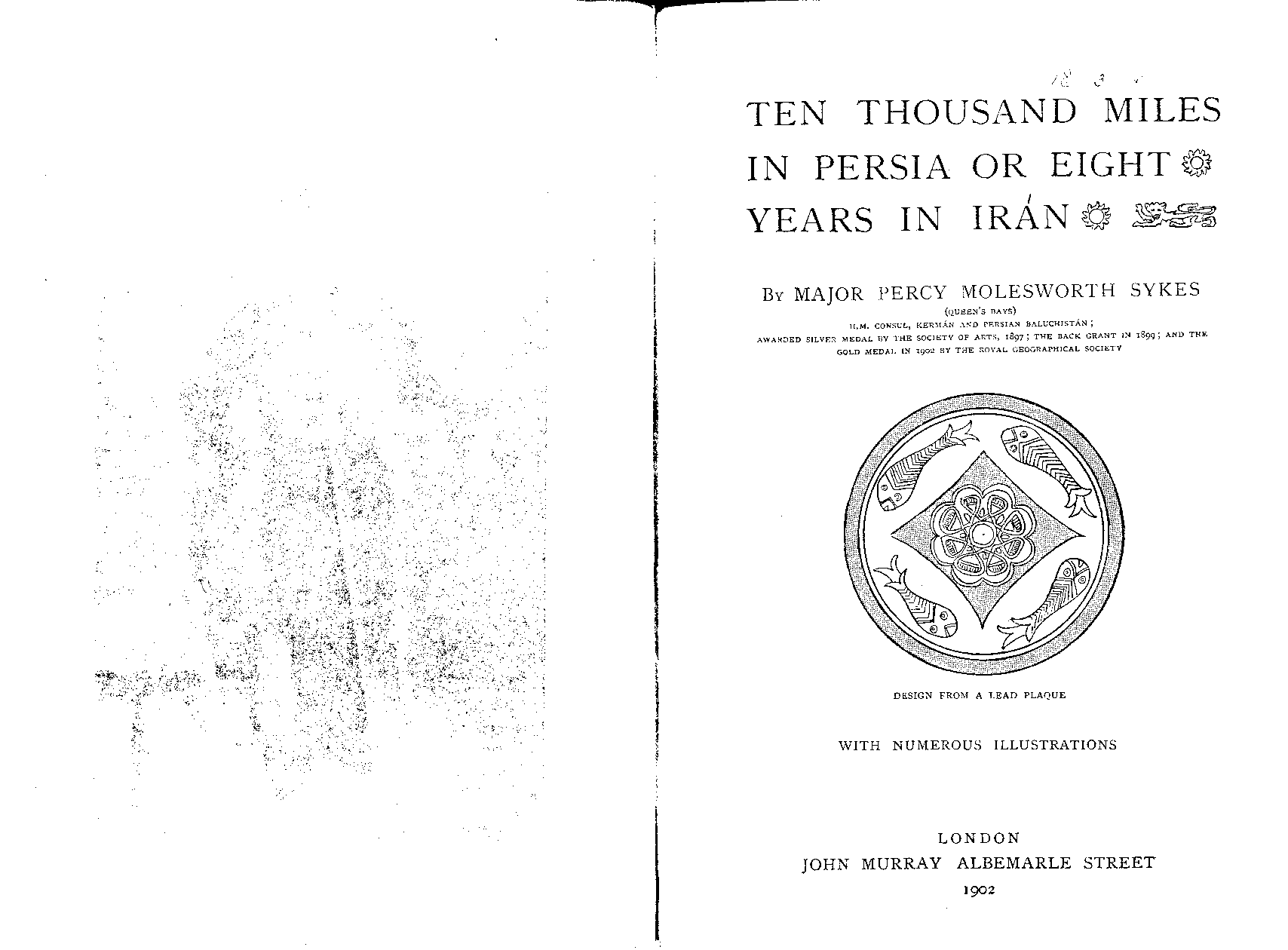
|
|
